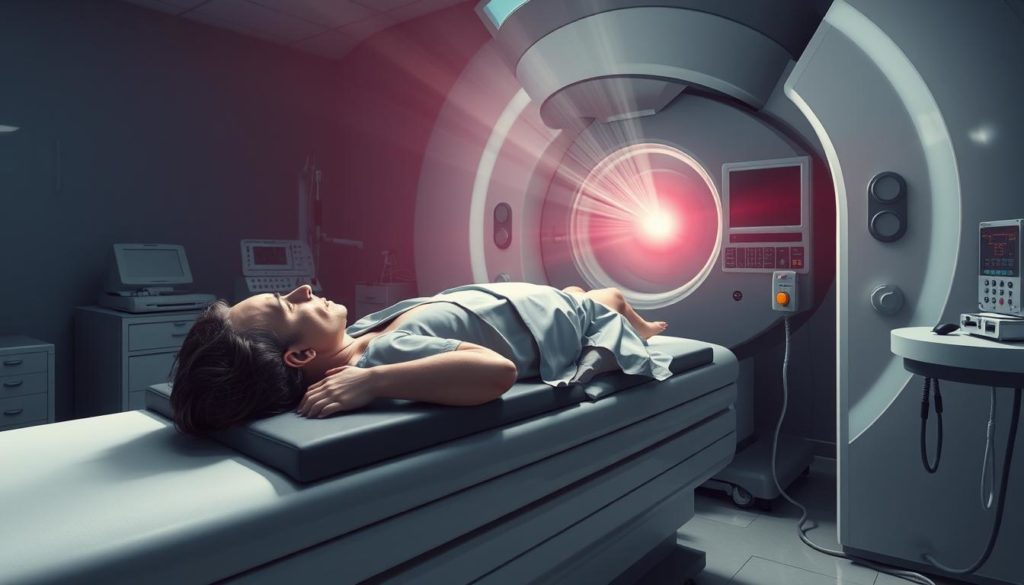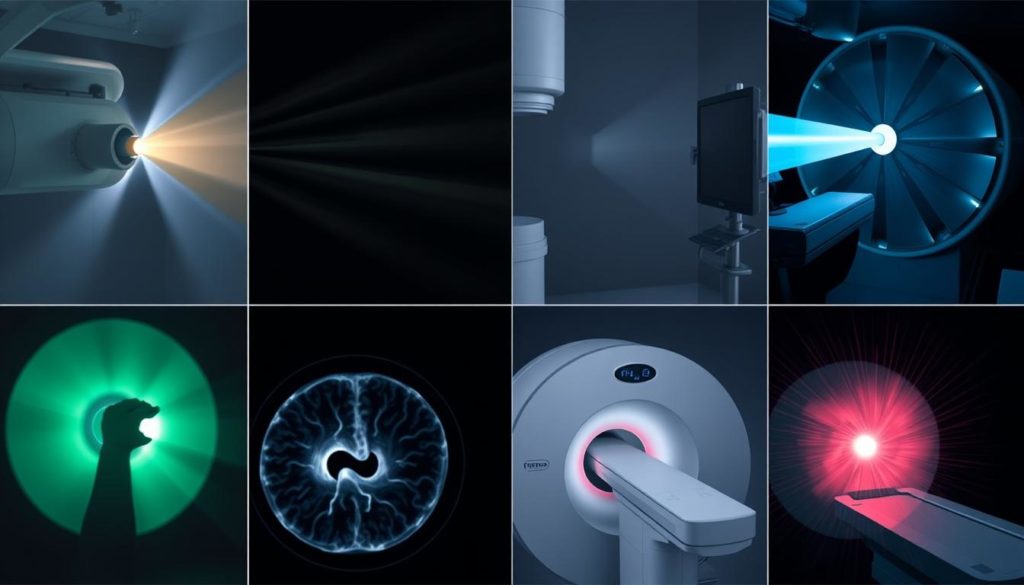About half of all men with prostate cancer will get radiation therapy. This fact underlines its key role in combating prostate cancer. High-energy rays or particles, like X-rays or protons, are used. They aim to kill cancer cells by harming their DNA.
Radiation therapy for prostate cancer is an effective choice. It can be the main treatment or part of a larger plan. The therapy uses advanced technology. It targets cancer cells while saving healthy tissue. For many, it’s a hope while battling their illness.
It caters to early-stage to more advanced or returning cases. There are many radiation therapies available. These include External Beam Radiation Therapy (EBRT), Brachytherapy, and Proton Beam Therapy. Each patient might find an option that fits their needs.
We’ll explore more about radiation therapy, its types, and its role against prostate cancer.
What is Radiation Therapy?
Radiation therapy is used to fight various cancers, including prostate cancer. It uses high-energy rays to destroy cancer cells but tries to keep healthy cells safe. It’s an important part of treating cancer, working with surgery and chemotherapy.

How Radiation Therapy Works
This therapy attacks prostate cancer by focusing energy directly on the cells. It ruins the cells’ DNA, stopping them from growing and causing them to die. The goal is to hit cancer cells hard while protecting healthy cells.
The process uses advanced imaging to aim very accurately. This means treatments are precise, targeting only the cancer cells.
Types of Radiation Used
There are different kinds of radiation depending on the cancer’s nature. The main types are:
- External Beam Radiation Therapy (EBRT): This sends radiation from a machine outside your body to combat prostate cancer. Techniques like 3D Conformal Radiation Therapy (3D-CRT) and Intensity Modulated Radiation Therapy (IMRT) make it possible to shape the beams. This matches the tumor’s size and form, spreading treatment over several weeks.
- Internal Radiation Therapy (Brachytherapy): This involves putting radioactive seeds inside the prostate gland. The seeds give off radiation for a time, hitting cancer cells close by while saving healthy tissue. It’s a focused way to treat prostate cancer, concentrating on the prostate area.
When Radiation Therapy is Used for Prostate Cancer
Radiation therapy is a very flexible treatment option for prostate cancer. It changes based on the patient’s stage and disease severity.

Early-Stage Prostate Cancer
Early-stage prostate cancer means the cancer is only in the prostate gland. Radiation therapy can be the main treatment in these cases. It helps cure the cancer at rates like radical prostatectomy while saving more of the prostate’s function.
Advanced Prostate Cancer
If the cancer grows more aggressive or spreads, doctors may use radiation with hormone therapy. This helps treat cancer that could grow quickly. The goal is to provide thorough care while focusing on preventing the disease from spreading.
Recurrent Prostate Cancer
Sometimes, prostate cancer comes back in the prostate area or somewhere else in the body. Radiation therapy is crucial for treating recurrent cancer. It targets leftover cancer cells after surgery or in case the cancer returns. Radiation is key in managing the comeback of the disease efficiently.
Types of Radiation Therapy for Prostate Cancer
A variety of techniques are used to treat prostate cancer with radiation. These include external beam radiation, brachytherapy, proton beam therapy, and radium-223 therapy. Each method has its own benefits. They are chosen based on how advanced the cancer is.
External Beam Radiation Therapy (EBRT)
External beam radiation therapy for prostate cancer uses high-energy beams from outside the body. It’s mainly for treating prostate cancers at an early stage. It can also help ease symptoms in more advanced cases.
Brachytherapy
Brachytherapy treatment places radioactive seeds inside the prostate. This delivers a high radiation dose right where needed. It also keeps the healthy tissue around it safer.
Proton Beam Therapy
Proton beam therapy benefits include its precision. It specifically targets cancer cells and protects healthy tissue. This method uses protons instead of X-rays. It often means fewer side effects for the patient.
Radium-223 Therapy
Radium-223 therapy is for prostate cancer that has spread to bones. It works like calcium, focusing on cancer in the bones. It helps with pain and strengthens bones.
External Beam Radiation Therapy (EBRT) for Prostate Cancer
EBRT treatment is a leading method against prostate cancer. It uses high-energy beams aimed at the prostate from outside. This precise method needs several treatment sessions.
Starting the process involves careful planning. Doctors use CT scans to map the prostate and find cancer cells. Key modern techniques in external radiation treatment for prostate cancer include:
- 3D Conformal Radiation Therapy (3D-CRT): Shapes the radiation beams to conform to the tumor.
- Intensity Modulated Radiation Therapy (IMRT): Modulates the radiation intensity during treatment.
- Image Guided Radiation Therapy (IGRT): Utilizes imaging during radiation therapy to enhance precision.
These advanced strategies target cancer effectively while protecting healthy cells. They use precise imaging and adjusted radiation. The goal is to minimize side effects and save as much healthy tissue as possible.
| Technique | Key Features |
|---|---|
| 3D-CRT | Customizes radiation beams’ shape to match the tumor |
| IMRT | Adjusts radiation intensity during each treatment session |
| IGRT | Uses real-time imaging to enhance treatment precision |
Using these methods in treatment reflects a strong fight against prostate cancer. It aims for the best results with the least harm to nearby areas.
Advanced Radiation Therapy Techniques
Radiation therapy is getting better at treating prostate cancer. Now, we have new techniques. These aim to hit cancer cells without harming nearby healthy tissues.
Intensity Modulated Radiation Therapy (IMRT)
IMRT is a big step forward in treating cancer with precision. It changes how strong the radiation beams are. This lets us target cancer more closely. By protecting the healthy tissues around it, we can reduce side effects. IMRT often comes with IGRT. IGRT helps us target cancer more accurately in every treatment.
Stereotactic Body Radiation Therapy (SBRT)
SBRT, or SABR, uses high radiation doses in a few sessions. Its precise aim makes it great for certain prostate cancer cases. Because of SBRT’s accuracy, less radiation hits the surrounding tissues. This can mean fewer treatment sessions and more comfort for patients.
Image-Guided Radiation Therapy (IGRT)
IGRT uses advanced imaging to make treatment better. By seeing the tumor clearly, we can aim the radiation perfectly. This way, the tumor gets the radiation it needs and healthy tissues are protected. IGRT and IMRT are often used together for the best results.
MRI-Guided Radiation Therapy
This approach combines IMRT’s benefits with MRI imaging in real-time. It’s very precise because it adjusts for tumor movements. MRI guidance lets us follow the tumor during treatment. This method is super accurate. It means we give radiation exactly where it’s needed, without extra exposure.
| Technique | Key Features | Benefits |
|---|---|---|
| Intensity Modulated Radiation Therapy (IMRT) | Modulates beam intensity, targets varying doses | Minimized side effects, enhanced precision |
| Stereotactic Body Radiation Therapy (SBRT) | High doses over few sessions | Precision, fewer treatments, improved convenience |
| Image-Guided Radiation Therapy (IGRT) | Uses advanced imaging for adjustments | Increased accuracy, dynamic targeting |
| MRI-Guided Radiation Therapy | Real-time MRI imaging with IMRT | Accounts for tumor movement, minimizes exposure |
Benefits of Radiation Therapy
Benefits of radiation therapy for prostate cancer are many. It’s highly effective for early and advanced stages. Techniques like Intensity-Modulated Radiation Therapy (IMRT) and Image-Guided Radiation Therapy (IGRT) aim radiation precisely. This way, cancer cells get destroyed but healthy tissues stay safe. It makes treatment for prostate cancer better.
New therapies reduce the number of treatments needed. This makes life easier for patients. For example, Radium-223 Therapy helps those with metastatic prostate cancer. It increases survival and eases bone pain, a common issue in late-stage disease.
Choosing skilled doctors at top centers makes a difference. They use cutting-edge technology. This ensures cancer is treated effectively while sparing healthy tissue. Such precision balances curing the cancer and managing symptoms.
In summary, radiation therapy is key in fighting prostate cancer. It can cure many, ease symptoms, and boost life quality. Thanks to ongoing innovations, it continues to be a crucial treatment option.
Side Effects of Radiation Therapy
Radiation therapy for prostate cancer has many benefits. However, it’s crucial to know the possible side effects. These effects can range in intensity but usually get better after treatment ends.
Bowel Problems
Bowel issues are common after radiation therapy. Symptoms like diarrhea and rectal leaking may occur. These are often temporary and can be helped with diet and medicine.
Urinary Problems
Urinary troubles are also a side effect. Symptoms include burning, increased need to urinate, and urethral strictures. Treatment often involves changes to fluid intake and medication.
Erectile Dysfunction
Erectile dysfunction can slowly appear after treatment. But, the good news is there are ways to manage it. Many men find help through medical care or lifestyle adjustments.
Fatigue
Fatigue is a common complaint during radiation therapy. It feels like being tired all the time. This fatigue usually goes away after finishing the therapy, letting people return to normal activities.
Lymphedema
Lymphedema is swelling from damaged lymph nodes after therapy. Managing it often requires physical therapy. However, it might not fully go away.
Comparing Radiation Therapy Options
When you need to choose a radiation therapy for prostate cancer, you should look at a few important things. These include how well it works, what side effects it might have, and how long the treatment takes. There are many types of radiation therapy that work well for prostate cancer that hasn’t spread. It’s key to compare these options to pick the best one for you.
Effectiveness
Both External Beam Radiation Therapy (EBRT) and Brachytherapy are really good at treating prostate cancer that hasn’t spread. Techniques like Intensity Modulated Radiation Therapy (IMRT) and Stereotactic Body Radiation Therapy (SBRT) are great at targeting the cancer precisely. This helps in getting better results. Proton Beam Therapy is another option that might be better because it doesn’t harm the surrounding tissues as much, but doctors are still studying this. Radium-223 is best for cancer that has spread to the bones.
Side Effects
Knowing the side effects of treatments is very important. A study from Vanderbilt University Medical Center shows that different treatments have different long-term side effects. For example, surgery might cause more issues with sexual function than radiation, but radiation might lead to bowel problems. SBRT might have more short-term side effects because it’s a stronger treatment, but IMRT and EBRT are usually gentler. You can learn more about side effects in this NIH research study.
Treatment Duration
How long treatment takes is also important. EBRT usually needs several weeks of visits, but SBRT is much faster, often just a week. Brachytherapy is a quick, one-time treatment. Proton Beam Therapy takes several weeks too, and it’s not as common because it’s expensive. When deciding on a treatment, think about how it fits into your life and what you prefer.
In the end, to choose the best radiation treatment, you have to think about the good and bad points of each type. Picking the right treatment depends on things like how advanced the cancer is, your overall health, and what you want to achieve. This will help get the best results from your treatment.
FAQ
What is Radiation Therapy for Prostate Cancer?
Radiation therapy for prostate cancer uses high-energy rays, like X-rays or protons. These rays damage the DNA of cancer cells, causing their death. It works for both early and advanced stages of the disease.
How does Radiation Therapy work?
This therapy sends energy beams to cancer cells. These beams damage their DNA, stopping them from growing. Eventually, the cancer cells die.
What types of radiation are used in prostate cancer treatment?
Doctors use external beams from a machine and internal radiation, or Brachytherapy, placing radioactive seeds in the prostate. Options like IMRT, IGRT, and Proton Beam Therapy are also used.
When is radiation therapy used for early-stage prostate cancer?
In early-stage prostate cancer, radiation can be the first treatment. It has similar cure rates to surgery.
How is radiation therapy used for advanced prostate cancer?
For advanced cancer, radiation is often paired with hormone therapy. It helps treat cancer that’s spread or manages symptoms in metastatic cases.
Can radiation therapy be used for recurrent prostate cancer?
Yes, it’s used if prostate cancer comes back. It can target cancer cells after surgery or treat the prostate region.
What is External Beam Radiation Therapy (EBRT)?
EBRT sends radiation from a machine outside the body to the prostate. It needs several sessions and uses techniques like 3D-CRT, IMRT, and IGRT. These help focus the treatment and protect healthy tissues.
What is Brachytherapy?
Brachytherapy involves placing radioactive seeds inside the prostate. This targets cancer cells with high radiation doses while sparing healthy tissues nearby.
How does Proton Beam Therapy differ from other types of radiation therapy?
Proton Beam Therapy uses protons, not X-rays, for a more targeted treatment. This may reduce harm to surrounding tissues.
What is Radium-223 Therapy?
Radium-223 Therapy treats prostate cancer spread to bones. It acts like calcium, targeting and treating the bones selectively.
What are the advanced techniques used in radiation therapy?
Advanced techniques include IMRT, SBRT, IGRT, and MRI-Guided Radiation. They all aim for more accuracy and fewer side effects.
What are the benefits of radiation therapy for prostate cancer?
Radiation therapy effectively treats all stages of prostate cancer. Some methods, like SBRT, need fewer sessions. They also offer chances for cure and symptom relief.
What are the common side effects of radiation therapy?
Side effects can be bowel and urinary problems, erectile dysfunction, fatigue, and lymphedema. They vary by person but tend to improve after treatment.
How do radiation therapy options compare in terms of effectiveness?
EBRT and Brachytherapy work well for localized cancers. Advanced methods like IMRT and SBRT offer precise treatment with potentially less side effects. Radium-223 is good for cancer in bones. The best choice depends on the cancer and patient needs.
What should be considered when comparing radiation therapy options?
Consider how effective they are, side effects, and the treatment length. Techniques like IMRT and SBRT target cancer well, while Proton Beam Therapy and Radium-223 are for specific cases. Your cancer stage, health, and goals guide the right choice.


